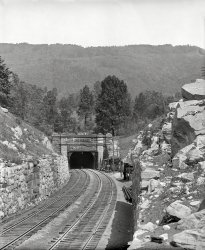
MAY CONTAIN NUTS

Search Shorpy
SHORPY ART

Framed or unframed, desk size to sofa size, printed by us in Arizona and Alabama since 2007. Explore now.
Join and Share
Ad-Free Shorpy
Shorpy is funded by you. Patreon contributors get an ad-free experience.
Learn more.

Recent comments
- Baldwin 62303
- Baldwin VO-1000
- Cold
- No expense spared
- Tough Guys
- Lost in Toyland
- And without gloves
- If I were a blindfolded time traveler
- Smoke Consumer Also Cooks
- Oh that stove!
- Possibly still there?
- What?!?
- $100 Reward
- Freeze Frame
- Texas Flyer wanted
- Just a Year Too Soon
- WWII -- Replacing men with women at the railroad crossing.
- Yes, Icing
- You kids drive me nuts!
- NOT An Easy Job
- I wonder
- Just add window boxes
- Icing Platform?
- Indiana Harbor Belt abides
- Freezing haze
- Corrections (for those who care)
- C&NW at Nelson
- Fallen Flags
- A dangerous job made worse
- Water Stop
Member Photos
The Shorpy
Print Emporium
Print Emporium
Search Shorpy
Search results -- 30 results per page
- Garage à Trois: 1940
- ... least a panoramic simulation:
(The Gallery, Railroads, Russell Lee) ... Posted by Dave - 04/27/2020 - 9:58am -
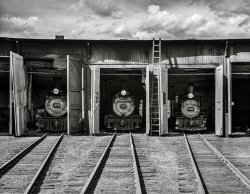
- Utility Boy: 1913
- ... is easier to judge by.
(The Gallery, Kids, Lewis Hine, Railroads) ... Posted by Dave - 09/28/2012 - 1:16pm -
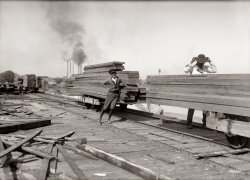
- Compleat Angler: 1901
- ... locomotive type.
(The Gallery, Boats & Bridges, DPC, Railroads) ... Posted by Dave - 04/12/2015 - 8:48am -
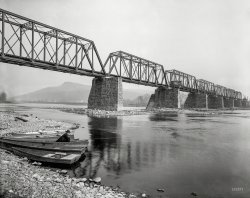
- Eats, Liquors: 1943
- ... pick out the riveted joint.
(The Gallery, Jack Delano, Railroads) ... Posted by Dave - 03/01/2014 - 10:57am -
![Eats, Liquors: 1943 March 1943. "Ash Fork, Arizona. Pulling into the Atchison, Topeka & Santa Fe railyard." With much helpful signage. Photo by Jack Delano. View full size.
+71Here's the Liquors building, albeit from a different angle. The well-camouflaged windowless brick building beyond the EATS sign still exists, as well. There is an encouraging amount of tree growth in the last seven decades, making it hard to see which humble bungalows survive.
View Larger Map
Long climb to WilliamsLooking east toward Bill Williams Mountain, and a little beyond that, the Navajo Army Depot, about a 2,000 foot climb from Ash Fork. The Depot was the prime holding area for munitions heading to the Pacific Theater until it was moved to Nevada later in the War.
Ash Fork is known as a flagstone producing and shipping center and its population of 400 is still holding on. The little town that could.
Why?This photo reminded me of a question from my youth (1950s) that nobody ever answered. Why do/did boxcars have those horizontal ridges on the ends? Were they to allow shelving? Were they an artifact of manufacturing? Or were they "just there"? Inquiring minds, etc.....
Those hills in the distanceare two miles away to the East, the tracks make a swing to the North and then a very circuitous route Eastward.
Escalante Hotel nearbyOff-camera (behind Delano, to the right) is one of the more notable Harvey House hotel/restaurant/depot complexes. Named the Escalante Hotel, it was constructed in 1907, and demolished in 1951. Only the boiler smokestack remains. Also to the right is the path of Route 66 through downtown Ash Fork.
Grainy - 35mm ?This photo is unlike any other Jack Delano photograph I have seen. Could this have been a "grab shot" with a 35mm camera?
[It's from a 2-1/4 square roll film negative, but presented here in greater magnification than many other Delano images shot in that format: 2700 pixels wide vs. 1900 for Women Wipers, for example. -tterrace]
[Or you can think of it as less reduced. The full-resolution image is 4252 pixels wide. - Dave]
Gulp & BlowIt looks like the 'Eats' shed and the 'Liquors' sign are strictly for the Railroad men - doesn't seem to be any access road around.
Another great Jack Delano railroad photoNote the collection of sand next to the standpipe on the adjoining rails. Obviously, steam engines with a train in tow would pull up and stop here for water. In order to get going again, the engineer would have to apply sand to the rails to overcome the inertia of getting his train back in motion. Nothing has changed, diesel locomotives have to carry sand for the same traction purposes too. It's still 'the steel wheel on the steel rail'.
Regarding "Why?"These boxcar ends are all steel stampings designed to hold the roof, walls and floor together. The horizontal corrugations were intended to give the end strength to resist the force of the lading pushing against the end. Without them a shifting load might just deform the end enough to break the rivet joints and tear the end out of the car.
These patterns all have names to the students of railroad freightcars. These ends on Illinois Central 28465(?) are pretty standard dreadnaught ends (as opposed to improved dreadnaught ends), probably built by Standard Railway Supply. They were a two part end, with the upper and lower halves joined by a rivet strip between them. If you look at the gap just below the tack board on the right (used to tack messages regarding car destination or handling en route), you can pick out the riveted joint.
(The Gallery, Jack Delano, Railroads)](https://www.shorpy.com/files/images/SHORPY_8d27380u1.thumbnail.jpg)
- Whirlpool Rapids: 1900
- ... ripped out during the Depression.
(The Gallery, DPC, Railroads) ... Posted by Dave - 06/22/2016 - 11:02am -
![Whirlpool Rapids: 1900 Circa 1900. "Whirlpool Rapids from Niagara Railway bridge, Niagara Falls, N.Y." 8x10 inch dry plate glass negative, Detroit Publishing Company. View full size.
Great Gorge Route1895-1935; more a victim of the automobile & Great Depression than a rock slide.
What is the purpose of the little house on the lower left? It looks like some kind of enclosed elevator system. Then the wooden walkway goes to another little house just around the bend.
Judging by the different color in the walkway a boulder (now sitting by the river's edge) has come crashing down.
(Later) Thanks to a Shorpy inspired afternoon, I find the walkway along the left bank is still there today. It looks like it may have been modified a couple of times. It's called the White Water Walkway. A tourist photo op in Niagra Park. I wonder if the building almost out of sight is a resturant or inn?
It looks like all the tracks are gone from the right bank.
Sight seeing from the city?The train car appears to be a street car from local town on a sight seeing excursion? Is the covered shed for the switchman? I noticed a couple of cross over tracks there also.
Whatizit?OK, I know it isn't a third rail, but what is on the outside rail (closest to the river), on the curve of the track the trolley is on? I see another set of this on the next curve behind the trolley too.
FYI, I am not referring to the guard rail inside the gauge.
edit:
Finding more rail oddities now. The repetition of unknown boxes back by the crossover and station, again on the river side, on the wooden catenary support poles is strange. Why so many?
edit #2:
John and all, thanks for the info on the name and location of the photos. With that I found:
[url]http://upload.wikimedia.org/wikipedia/commons/2/28/Niagara_Gorge_Railroad.jpg[/url]
This photo clearly shows that 'third rail' as another type of guard rail for the event of a riverside derailment, it would hopefully keep the trucks from veering any further into the gorge. No insulators seen supporting it and confirmation of trolley pole fed power.
Around the GorgeThis link:
https://www.shorpy.com/node/8978?size=_original#caption
and others of downtown Buffalo include ads for the trolley car.
"Around the Gorge Summer Excursions 75 cents"
They did mean both sides of the Niagara River, the opposite side of the "Around" was on top of the other cliff, see the row of poles at upper left. Yes, it was an International streetcar line.
Postcard closeupsTwo of the three postcards shown here:
http://30squaresofontario.blogspot.ca/2012/01/niagara-falls-trolley-card...
might give a little more insight into track and trolleys.
Thanks for posting this picture. I haven't seen an overview of this trolley line before.
Some AnswersBilly B: That house on the left is the bottom entrance to the elevator for the Whitewater Walkway (been there several times) on the Canadian side and also a gift shop for tourists. It's still there and was even seen in the movie "Superman 2".
Billy B & MrK: Those tracks were part of an excursion line that ran along the bottom of the gorge on the American side. The line ceased operation about 1918 after a couple of rock falls wrecked the tracks. It ran from Lewiston NY south to about where the Whirlpool bridge is now. There was a turnaround and the passengers would ride back to Lewiston. The tracks were ripped out during the Depression.
(The Gallery, DPC, Railroads)](https://www.shorpy.com/files/images/SHORPY-4a19733a.thumbnail.jpg)
- A Pretty Grille: 1941
- ... million dollars.
(The Gallery, Cars, Trucks, Buses, Railroads, San Francisco) ... Posted by Dave - 12/29/2014 - 2:28pm -
![A Pretty Grille: 1941 San Francisco, 1941. "Pontiacs being unloaded from freight cars." Slathered with chrome. 8x10 Eastman Kodak Safety Film negative. View full size.
Last of the New Cars for ConsumersI'm supposing that these are being unloaded not long before the attack on Pearl Harbor.
These represent the last model year of new cars available to consumers until World War 2 was finished. Sales of new automobiles were severely limited for the duration.
[You're a year off. These are 1941 Pontiacs; 1942 was the last model year for new cars before the war. - Dave]
Note that the Pontiacs are being unloaded from special end-door RR boxcars. The boxcars shown have now-obsolete features such as full-height ladders and roof walks. Examining the boxcar doors close up will reveal minor damage.
Autos are still shipped extensively by rail, but the current auto carriers have three decks!
Put them back in the freight carThen wait 75 years and open it again.
What a time capsule that would be!
Illuminating?I refer to the hood ornament which looks like clear plastic and just might have lit up at night.
Barn FindReminds me of an urban legend current when I was young in Minnesota circa 1980. A boxcar (or two, or three) filled with 1949 Hudsons or '42 Chevys or (fill in dream car here) was found, lost by the railroad for decades, on a siding in Michigan or Ohio or Canada. Ah, well. Great photo.
Chief Pontiac's faceDid not light up until 1949.
Bryant StreetBuilding in background is the Hamm's Brewery at 1550 Bryant Street. See this photo across railroad loading docks. My guess is that the photo was taken at the former site of the Southern Pacific 16th Street freight depot, located around Treat Street between Florida and Harrison. The Shorpy photo and the one below both appear to be from around Treat Street. looking towards Florida. A 1960s track diagram for the Southern Pacific doesn't indicate a match for the freight sheds and ramp for unloading (see Zone 8 page 1). The track diagram does indicate track 828 was the "old 16th Street Freight Depot," suggesting the tracks had been rearranged before 1960.
Interesting story here.The type of railroad car is an "end door" type. They were designed for carrying automobiles, or larger loads. The end doors were only on one end though, meaning that to unload, you had to move the cars around after each was emptied. Bout twenty years ago, in a small town in Georgia, they stumbled across three of these cars abandoned in an old yard. Took some working to figure out, but the cars had apparently been lost in transit to a local dealership in Savannah. Sidelined due to something wrong with the trucks (bogies the cars ride on.) The cars were just forgotten. Well, when the crews found them, they asked what to do and were told to just scrap them. Opening the doors, they found that each car held three brand new Ford Galaxies, with all of six miles on the odomoter. The owner of the company doing the demolition took two for himself, and divided the remaining cars among his crew. One of the cars sold at Barret's auto auction some years back, with the winning bid being over one million dollars.
(The Gallery, Cars, Trucks, Buses, Railroads, San Francisco)](https://www.shorpy.com/files/images/SHORPY-171-01.thumbnail.jpg)
- Seeandbee: 1912
- ... final dimensions. The 1888 is the year of manufacture as railroads like to keep track of how long things last and for the past hundred ... Posted by Dave - 01/12/2012 - 6:07am -
![Seeandbee: 1912 November 9, 1912. Wyandotte, Michigan. "Steamer Seeandbee on the ways just before the launch." 8x10 glass negative, Detroit Publishing Co. View full size.
Strange fateShe became in 1942 the USS Wolverine (IX-64), a converted training carrier. The only one of two sidewheeler carriers ever.
It Wasn't Finished YetThey must have finished it off while it was in the water. Here's what it looked like finished.
Seeandbee's Future AccomplishmentsEarly on in WWII, the Seeandbee (along with the Greater Buffalo) were purchased by the Navy and converted into the world's only freshwater, coal-fired, paddlewheel aircraft carriers (The USS Wolverine and the Uss Sable, respectively), for training pilots. Both were scrapped at the end of the war.
The Namewas selected by contest, and Seeandbee stood for "C&B" -- Cleveland & Buffalo, the railroad that owned her.
Sidewheeler to carrierIn WW II the Seandbee was converted to the USS Wolverine, a training carrier (or "unclassified miscellaneous auxiliary", acto the navy). One GHW Bush qualified for carrier duty on her sister training ship, the USS Sable.
TensionIt must be a really tense time, standing there, just waiting for someone to give the signal and see this marvelous ship slide into the water. And float [hopefully]. I like the lady in the lower right corner with the babe in arms, I'd step back a bit further if I were her, just in case.
All together now, on the count of three:So when it is time to launch it do all of those guys under the ship knock out their respective support poles and then duck quickly between the rails that it uses to slide sideways into the water?
What happens if one or more of the poles are not cooperative about knocking loose or someone misses the three count?
Sounds to me like an occupation that life insurance companies would certainly shy away from.
I must be missing something, there must be a better way. Please enlighten us Shorpy.
No Ducking RequiredIf I'm not mistaken, the poles aren't pulled out from under the hull at launch. The ship and the support poles are all resting upon those topmost inclined planks, and it's the planks which are being held in place from the other side. Their anchorage is removed, and the whole system, ship, poles and planks, slides off.
Splash Zone?A new launch looks like a popular spectacle, but I wonder if the front rows, close to the near side of the ways, is a Shamu-style splash zone!
"Please leave all Kodaks and radio equipment in your automobiles, as the management cannot be responsible for damages!"
Honeymoon and TailhookMy late friend graduated from the US Naval Acadmedy in 1941 and married, spending his honeymoon on a SeeandBee voyage. He then became a Naval Air Pilot and practiced carrier landings and take-offs from the same ship renamed the USS Wolverine. Certainly he and his wife were one couple of maybe a few who could have ever claimed to have spent their honeymoon on an aircraft carrier.
Proto-taggingAll you commenters from last week: the railroad car in the foreground appears to have some sort of pre-spray paint graffiti on it, including what looks like a stylized letter "T".
Old wheelI like the flatcars wheel - forged with the year 1888.
Also, when they launch ships like this, how do they / DO they recover the wood rigging that slides into the water? Does it sink? Float?
Flat car wheelThat wheel has been cast, not forged. The number is probably a serial number.
More freight car wheels !Freight car wheels are forged not cast as they are made of steel and turned to the final dimensions. The 1888 is the year of manufacture as railroads like to keep track of how long things last and for the past hundred years or so it has been required by the Feds.( retired railroad machinist)
Fire SafetyThe Seeandbee represented a step forward in providing fire detection and suppression built into the vessel. Perhaps that, along with large size, made her a suitable candidate for conversion to an aircraft carrier. While steam-driven side-wheel paddlers were approaching their final days when the Seeandbee was launched, it was still considered by some to be superior propulsion system for maneuverability and passage through ice.
Safety Engineering, Vol. 26, November, 1913.
A New Era in Steamship Equipment
At last a steamship company has constructed a vessel in which the fire peril has been considered as important as length, breadth and comfort.
There has recently been launched the largest and most costly passenger ship on inland waters—the "Seeandbee"—built by the Detroit Shipbuilding Company, and owned by the Cleveland and Buffalo Transportation Company. This vessel plies between Cleveland and Detroit. The "Seeandbee" is 500 feet in length and has sleeping accommodations for 1.500 passengers. In the design and equipment of this vessel, nothing in the way of comfort has been omitted.
A new element of safety has been introduced. Contrary to the almost universal rule of steamship construction, the owners of the "Seeandbee" have afforded protection against fire for the passengers. The Aero Fire Alarm Company, New York, has equipped the ship throughout with the Aero Automatic Fire Alarm System. Sprinklers have been installed. How many passenger-carrying steamships carry such protection against fire?
Examples have been frequent recently of the terrible destruction which fire accomplishes when it appears on a vessel unequipped to speedily detect and extinguish fire outbreaks. Thousands of lives are jeopardized each day on board firetrap ships, the owners of which refuse to consider seriously the grave danger to life from the fire peril which exists in their vessels. The Cleveland & Buffalo Transportation Company has set an example in providing for the safety of passengers, which can well be followed by other steamship owners. The "Seeandbee" represents a great step forward in steamship construction.
The Aero Automatic Fire Alarm System consists of a fine copper tube which is extended in loops throughout the entire ship. Both ends of these loops are returned to a cabinet, which, on one end, contains a sensitive diaphragm, which moves sufficiently to touch an electrical contact point on the occasion of fire breaking out in the ship. Fire causes a rapid rise of temperature, and thus the air in the tube expands and so operates the diaphragm. The other end of the circuit terminates in a testing valve, which is opened at the time of testing into an air pump, by which pressure is created in the tube similar to fire pressure, causing the diaphragm on the other end to make the electric contact and carries out in exact manner the operation of the system in the event of an actual fire. …
More on RR wheelsThose wheels are cast. The date of manufacture is included in serial numbers today per AAR regulations. I don`t know if that was true in 1888. All wheels made in North America today are cast except for the following manufacturer. http://www.standardsteel.com/history.html Forged wheels are required for passenger service and some freight cars. Most cast wheels today have the serial numbers on the back plate raised above the surface. Forged wheels have numbers stamped into the back hub or rim face.
Retired wheel machinist.
Last word on RR wheels?All the previous posts are partially correct in their own way. The wheel in question is almost undoubtedly a cast wheel. The raised lettering is a clue. The 1888 is also undoubtedly the date of manufacture.
Railroad car wheels are currently manufactured both by forging and by casting. I believe that cast wheels comprise a larger segment of the new wheel market, due to lower cost. These are cast STEEL wheels, not cast iron, manufactured in highly automated facilities.
However, a wheel cast in 1888 is most likely a cast IRON wheel. The real visual ID on these are the cast-in cooling ribs on the reverse side. More than anyone likely wanted to know about a minor detail in the foreground!
John G (former RR Car Dept. Manager)
Where's WaldoI think I have found him and his twin brother wearing identical knit caps in the front, near the water, to the right of center.
(The Gallery, Boats & Bridges, DPC)](https://www.shorpy.com/files/images/SHORPY_4a16221a.thumbnail.jpg)
- Illinois Central: 1942
- ... and switches.
(The Gallery, Chicago, Jack Delano, Railroads) ... Posted by Dave - 07/21/2014 - 12:40pm -
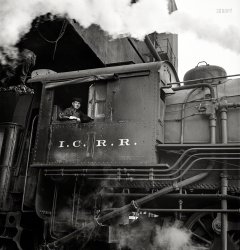
- Needles: 1943
- ... not an interchange move.
(The Gallery, Jack Delano, Railroads) ... Posted by Dave - 01/23/2013 - 5:33pm -
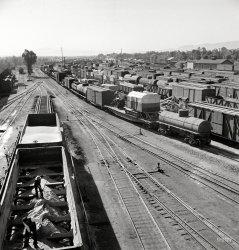
- Electro-Motive: 1943
- ... this transition took place?
(The Gallery, Jack Delano, Railroads) ... Posted by Dave - 03/11/2015 - 11:21am -
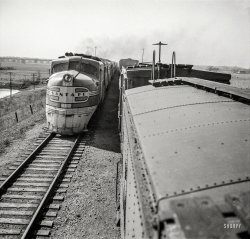
- Hotel Nicollet: 1905
- ... I miss her!
(The Gallery, DPC, Minneapolis-St. Paul, Railroads) ... Posted by Dave - 06/23/2017 - 10:29am -
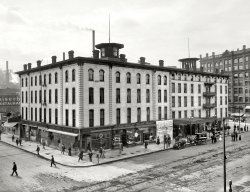
- River Traffic: 1898
- ... . - Dave]
(The Gallery, Boats & Bridges, DPC, Railroads) ... Posted by Dave - 01/23/2019 - 12:09pm -
![River Traffic: 1898 The Mississippi River circa 1898. "Winona, Minnesota. The levee below the bridge." At left, the sternwheeler Lafayette Lamb. 8x10 inch dry plate glass negative, Detroit Photgraphic Company. View full size.
Answered my own questionThe Winona Bridge had a swing span
“The bridge was built from the Wisconsin shore across the back channel to Island 72, now known as Latsch Island, across the main channel to the Winona shore. In the middle of the channel, a huge stone pylon was built up from the riverbed, and a steel and wood beam span was built on top of it. This section of bridge was designed to pivot on that center support, swinging parallel to the shore to allow steamboats, barges and log rafts to pass unimpeded. A tender's shack stood at the pivot point to shelter the rail roadman, who set the machinery in motion to swing the bridge closed when a train approached. At 363 feet, its swinging span -- the "draw" -- was the longest in the world.”
https://www.winonadailynews.com/special-section/pieces-of-the-past/thurs...
Bridge Over Troubled WaterTwo bridges can be seen in this photo. One had been around for more than 25 years. The other, much bigger, was pretty new at the time. From a 1960s report for the Interior Department, addressing both:
Although a railroad bridge connected Winona to the Wisconsin shore as early as 1871, the city had no direct highway access for another two decades. Teamsters made do with a ferry that carried them over the Main Channel to Latsch Island; there they disembarked onto a long wooden trestle that spanned the North Channel and the river's remaining expanse. In 1892, the ferry finally gave way to Bridge #5930, Steel, cantilever, through-truss design, the span was a municipally financed project designed to make Winona the main trade center for its Wisconsin neighbors. To retire the construction debt, the city administered the new "High Wagon Bridge" as a toll crossing.
By the 1930s, auto traffic was making the now "old" high bridge obsolete, with its zigzag connection to an older North Channel wagon bridge a serious impediment.
A new span was designed and survives today about a quarter mile up river from the bridges seen in the photo above. Ironically, an updated form of the original North Channel wagon bridge survives for non-motorized traffic.
Full stop?Why do you suppose they put a period after "Lamb"?
[Period signage. - Dave]
Period signage. Nice.I think Dave would be absolutely miserable if confined to a language where all words have only one meaning.
Clouds? Sky?Just realized that the sky has clouds. Was this shot with panchromatic film?
[This wasn't shot with any kind of film. It's a glass plate negative. - Dave]
(The Gallery, Boats & Bridges, DPC, Railroads)](https://www.shorpy.com/files/images/SHORPY-4a04017a1.thumbnail.jpg)
- Harbor Belt: 1943
- ... like an IHB tower to me.
(The Gallery, Jack Delano, Railroads) ... Posted by Dave - 01/23/2014 - 6:52pm -
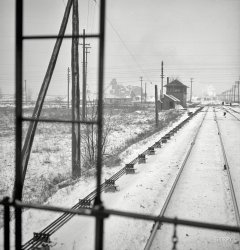
- Central Furnace Works: 1908
- ...
(The Gallery, Cleveland, DPC, Factories, Railroads) ... Posted by Dave - 10/12/2012 - 5:52pm -
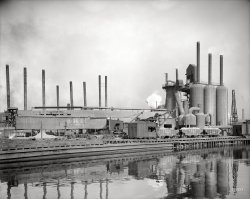
- Riverdale: 1923
- ... Center.
(The Gallery, D.C., Harris + Ewing, Railroads, Streetcars) ... Posted by Dave - 07/01/2018 - 12:10pm -
![Riverdale: 1923 Washington, D.C., circa 1923. "View of Naval Observatory and Washington from Massachusetts Avenue hill." Harris & Ewing glass negative. View full size.
Riverdale?Dave, I didn't remember the Naval Observatory, but something that high wouldn't have been near the railroad. The Naval Obs. is southwest of Riverdale, on the opposite side of center city. It's just a bit north of Georgetown; that's not considered Riverdale, is it? Harris & Ewing certainly should have known where they were. This view is looking towards Arlington/Rosslyn, Va. across the river.
What I said about Riverdale is quite true. As for the Georgetown neighborhood, I've run a few trains down there as well, on the long-gone Georgetown-Silver Spring branch.
["Riverdale" is a pop-culture reference. - Dave]
Been thereI've driven through the outskirts a few times; I've pulled a LOT of freight trains through there; I've even piloted a few MARC commuter jobs through Riverdale, but I never saw it look as appealing as it does in this old photo. (That heavy humidity looking like smoke, is still there in season.)
JuxtapositionsI think it must be the juxtaposition of familiar still extant landmarks with bits of forest and anytown USA houses that makes this look like the best Model Train layout ever to me. My reaction is completely different than it has been to many other circa 1923 pictures on Shorpy!
This is, for me, a view of my childhood somehow perfectly blended with the world of my grandparents, rather than a straight picture of the distant past.
Amazing PhotoShows just how small Washington was back then. And why Cleveland Heights was considered a good place to go to escape the "City." Love to see a photo from the same spot today. I'd guess the Alban Towers wasn't even a dream yet.
Confused by VirginiaThe Virginia side is pretty hilly around the cemetery, and rises over towards Crystal City. Everything on the Virginia side looks flat. Does anyone see Arlington House?
[The hilly parts along the river are north of Rosslyn, out of frame to the right. Where today's Memorial Bridge crosses into Arlington, it's flat. Below, a Google Earth screen grab. Arlington House is the red dot. - Dave]
Confusing PerspectiveThis is a really confusing perspective. It would appear that these are the Wisconsin Avenue streetcar tracks and that the shot was taken from somewhere near the intersection of Wisconsin and Massachusetts Avenues. You can see the Lincoln Memorial in this picture, which was completed in 1922, but not the Memorial Bridge, which didn't begin construction until 1926. What I'm having a hard time understanding is where is Arlington National Cemetery in this picture?
[The Potomac as seen in this view is C-shaped and loops from top right to the left, then back to middle right. Virginia is on the right, between the arms of the C. Click the handy locator map below. - Dave]
Capital TractionIf you look down toward Georgetown, you can make out the twin stacks of the Capital Traction power plant (built 1910-11). The incinerator that sat across the street and had a tall stack had not yet been constructed when this photo was taken, as it went up around 1932. The other stacks are, I believe, industries located along the C&O Canal, one of which, a shop that ran along Grace Street, is still extant -- even the smokestack!
Staying PowerIt looks like several of these structures are still around in 2018.
In 1913, the building at 3600 Calvert Street NW was 11 years old and served as the schoolhouse for an orphanage and reformatory called the Industrial Home School. In the 1950s, the residents of the school were moved to Laurel, Maryland. The main building was torn down. The schoolhouse became the Guy Mason Recreation Center.
(The Gallery, D.C., Harris + Ewing, Railroads, Streetcars)](https://www.shorpy.com/files/images/SHORPY-13672a1.thumbnail.jpg)
- Detroit on the Ways: 1904
- ... engines perhaps??
(The Gallery, Boats & Bridges, DPC, Railroads) ... Posted by Dave - 08/02/2013 - 10:20am -
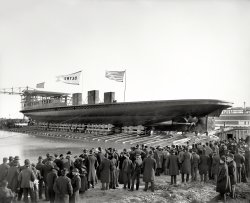
- Municipal Light: 1940
- ... 5th day of the month.
(The Gallery, Frontier Life, Railroads, Russell Lee, Small Towns) ... Posted by Dave - 09/01/2018 - 6:07pm -
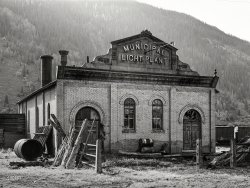
- Brooklyn Bridge: 1900
- ... the roads were dreadful due to travel being diverted to railroads. Large bridges were built to carry railroads, street car lines, and a smattering of foot and horse traffic.
... Posted by Dave - 08/01/2012 - 5:36pm -
![Brooklyn Bridge: 1900 New York circa 1900. "Brooklyn Bridge, East River." 8x10 inch dry plate glass negative, Detroit Publishing Company. View full size.
Age of Steam and HorsesEach time a see a circa 1900 urban scene on Shorpy, I ponder how technology was so slow in developing the automobile in comparison to the other machines and structures in existence at the time. I am alway struck by the incongruity of large urban buildings surrounded by horse drawn wagons. This picture really drives the point home. Let us not forget that the unseen traffic crossing this magnificent bridge at its opening was mostly horse-drawn or pedestrian. The big boats in the water were steam powered. The age of the ubiquitous gasoline engine was yet to come.
Best deal I ever made!Only paid $500, and I've got the title to prove it.
Re: Best deal I ever made!Cool, I'll give you a call once my Nigerian money comes through.
Public and Private TransitThe development of the "ubiquitous gasoline engine", and the parallel development of petroleum, was the key required to unlock the door to personal vehicles. We could have conceivably gone with electric propulsion, but electricity didn't become widespread until the late 1800's and it was generally in an inconvenient form for recharging slow, heavy, and quick-to-run-down battery powered cars. The light, speedy, indefatigable, and ultimately cheap gas motor won the day. Throughout the 19th century, occasional experimenters demonstrated steam-powered carriages or "road locomotives" but the skills and attention required to manage a steam engine were unrealistic for a solo driver, and the roads were dreadful due to travel being diverted to railroads. Large bridges were built to carry railroads, street car lines, and a smattering of foot and horse traffic.
[Steam-powered automobiles (Dobie, Stanley etc.) attained a certain measure of popularity. In the final years of the 19th century, the Stanley brothers' steam-powered vehicle was America's top-selling motor car. The company they founded lasted a quarter of a century. - Dave]
(The Gallery, Boats & Bridges, DPC, NYC)](https://www.shorpy.com/files/images/4a08213a.thumbnail.jpg)
- America: 1900
- ... capacity once passengers defected to the much faster railroads. But they pushed their share of barges after that. There was a ... Posted by Dave - 08/20/2012 - 9:53am -
![America: 1900 "America, Mississippi riverboat, circa 1900-1910." Note the group of convicts in prison stripes. Detroit Publishing Company glass negative. View full size.
Sam'l Johnson would have loved it:Going to prison, with a chance of drowning, indeed!
ConvictsAre the convicts on the way to prison or did the riverboats use them as free or cheap labor?
SternwheelerI can never see a photograph of a paddle boat without thinking of Mark Twain. It's such a shame that these lovely ladies went the way of the dinosaur.
Mark Twain's river steamers.Contributor "heks" rightly mentioned Mark Twain. He worked as a river boat pilot for a while. You could do worse than read his book "Life on the Mississippi." Then read his follow-up book, "Roughing It," about his trip west to Virginia City -- the tale of Tom Quartz, the mining cat, is particularly precious and, not to forget, hilarious -- and on to San Francisco, thence to Hawaii. These are by far his best books -- and probably the least known! A superb photograph.
The ConvictsObviously they are being sent "up the river"
Mark TwainI've been thinking about Mark Twain during these, too. Finished "Life on the Mississippi" late last year, finished "Roughing It" this year. Interestingly enough, Mr. Clemens would leave us to believe the river boat was long dead by the 1870s-1880s, but the dates of these pictures show not so. Probably nowhere near the traffic levels at its height, but it takes a long time for a transport model to completely die.
Sternwheel LongevityThey actually lasted longer than most people think, though in a freight hauling capacity once passengers defected to the much faster railroads. But they pushed their share of barges after that. There was a working sternwheeler around Charleston WV on the Kanawha River (Ohio River tributary) into the 1980s. It was a small one used to shuffle coal barges around a loading terminal, and was most likely diesel powered. Used to see it all the time when I was out fishing.
Long-lasting river navigation.Contributor "Jim" is correct that it takes a long time for any form of transport to completely disappear. Here in New Brunswick, Canada we had stern-wheelers, side-wheelers and screw ships on the St. John River and the various arms of the river. The last run of the last serving ship, the Motor Ship D. J. Purdy, downbound from Fredericton, where I live, to Saint John, was September 30, 1946. The record runs of several of the boats on the St. John River were faster than the Canadian National Railways trains that pretty well followed the river! Granted, the railway was very much a secondary line, not a main line, but still . . . .
I have a set of the 1977 navigation charts for the river, very interesting.
S. S. KlondikeCanadian riverboats have shown up a couple of times in the comments, so I'll add my two bits.
The S.S. Klondike operated on the Yukon River until 1955. She presently sits on the bank of the Yukon River in Whitehorse, where I drive past her every day.
The Klondike has been meticulously restored by Parks Canada. If you are ever in this neck of the woods the tour is worth every penny.
More info here (there is some fantastic 8mm film shot in 1941 on that site).
[I've been to Whitehorse! The Yukon Territory and northern British Columbia are spectacularly gorgeous. - Dave]
Fire CanoesThere were steamboats (sometimes called "fire canoes" by the Native people) on the Saskatchewan River system from the 1860s into the 1910s. The last sternwheeler to work the lower South Saskatchewan was the City of Medicine Hat which had an unfortunate encounter with the Traffic Bridge in Saskatoon in 1908 and sank. Sternwheelers worked the Mackenzie River in the Northwest Territories until around 1940.
While it's true that train travel was faster and more efficient for passengers, it is also a fact that the most economical means for transporting bulk cargoes - in terms of cost of energy per ton of goods per mile is moving them by water...when you can. Sternwheelers then, tugs and barges today make a tremendous amount of sense.
Convicts on the SteamboatI did a little internet research, being curious about the convicts in the picture. This appeared in "Plantation Days at Angola: Major James and the Origins of Modern Corrections in Louisiana."
Until he died in 1894 (the lease survived him, not expiring until 1901), Major James ran what Dr. Carleton has called "the most cynical, profit-oriented and brutal prison regime in Louisiana history." Convicts worked on private property--both Major James's and that of other plantation owners who sub-contracted their labor --for the profit of the lessee, Major James. They worked the land, farming and cutting timber, they performed as household servants, they travelled not only "up the river" but down the river as well, on Major James's steamboat, repairing and building levees in the never-ending struggle to contain the Mississippi and protect the rich farmland.
History of Riverboat "America" 1910I would like to find more info concerning the Riverboat "America" during 1910. My grandfather worked on it as a carpenter but died in 1918. Since then all his children also are deceased but info in my father's writings stated the above info. There was another "America" but it collided with another steamship, flipped, and burnt at Warsaw, KY in 1890's.
(The Gallery, Boats & Bridges, DPC)](https://www.shorpy.com/files/images/4a17928u.thumbnail.jpg)
- New Orleans: 1935
- ... on right would be for the Southern RR and for the GM&O Railroads. Street would be Toulouse, maybe. Those houses were still there at ... Posted by Dave - 09/07/2011 - 6:09pm -
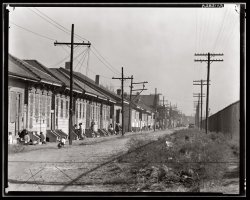
- Junior Marines: 1919
- ... (The Gallery, Cars, Trucks, Buses, D.C., Harris + Ewing, Railroads) ... Posted by Dave - 08/29/2012 - 2:13pm -
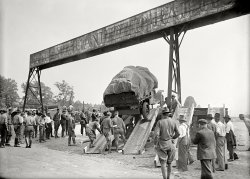
- Cu Cu Train: 1942
- ... a decade.
(The Gallery, Andreas Feininger, Mining, Railroads) ... Posted by Dave - 10/23/2013 - 4:39pm -
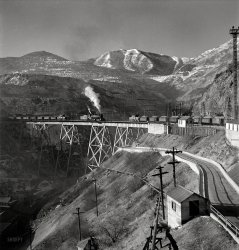
- Jamaica Avenue El: 1944
- ... front of it.
(The Gallery, Gottscho-Schleisner, NYC, Railroads) ... Posted by Dave - 02/06/2013 - 5:40pm -
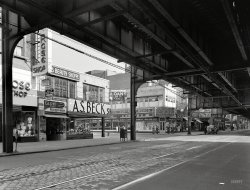
- Full Steam Ahead: 1913
- ... guys.
(The Gallery, Boats & Bridges, Harris + Ewing, Railroads) ... Posted by Dave - 08/18/2014 - 4:59pm -
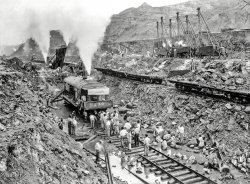
- Terminal Station: 1910
- ... that would have made.
(The Gallery, DPC, New Orleans, Railroads) ... Posted by Dave - 03/06/2019 - 11:18pm -
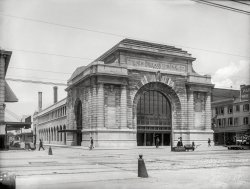
- Capitol Refining: 1925
- ... shot better, I think.
(The Gallery, D.C., Natl Photo, Railroads) ... Posted by Dave - 09/11/2011 - 6:42pm -
![Capitol Refining: 1925 A glimpse at the industrial side of Washington circa 1925, labeled "Capitol Refining Co. plant." This tank farm, where the Pentagon stands today, was described at the time as being in "Relee, Alexandria County, just south of the highway bridge." National Photo Co. Collection glass negative. View full size.
OMG!I hate it when Giant Amoebas attack!
Cattle, Cotton & Oil, Oh My!I find it curious how this site evolved from a stockyard and abattoir (slaughterhouse) into a cottonseed oil refinery and then finally the petroleum refinery pictured. The cotton-seed oil may have been used for food or industrial applications such as lubricants and paint. I wonder if equipment for refining cottonseeds could be reused to refine petroleum?
[Were any of these petroleum tanks? - Dave]
Update: After seeing the later White Dome post, I am pondering if perhaps the "refining" refers only to vegetable and animal oils and not to petroleum products at all. I guess its my fossil-fuel-centric lifestyle that led me to the conclusion that this was a petroleum refinery - that and pre-conditioning due to the long series of photos of service stations on Shorpy.
Washington Post, Jun 5, 1908
Packing Plant For City
Washington's industries are to be increased here of a plant with an annual output valued at from $4,000,000 to $5,000,000. The company, to be known as the Columbia Cotton Oil and Provisions Corporation, proposes to absorb the Washington and Virginia Stock Yard and Abattoir Company and to enlarge the plant and add equipment, not only for slaughtering of cattle, but for the refining of crude cottonseed oil.
...
The proposed plant, it is said, will be the only one of its kind east of Chicago and south of New York, and the only complete compound plant on the coast between New York and Savannah.
...
The annual capacity, according to figures submitted to the manufactures committee of the Chamber of Commerce, will be 100,000 barrels of crude cotton-seed oil, 125,000 hogs, 10,000 cattle, and 25,000 sheep and calves which will be converted into lard, lard compound, lard substitute, cooking oils, lard stearine, oleo stearine, hams, bacon, sausage, canned meats, fertilizer, hides, and a variety of fresh cuts to be put on the market.
Washington Post, Jun 2, 1913
Refiners Buy Oil Plant
The Capitol Refining Company, which was recently granted a charter by the Virginia corporation commission, has purchased the plant of the Columbia Cotton Oil and Provisions Corporation, at Relee, near Arlington Junction, Alexandria county. The Capitol Refining Company is a subsidiary of the Jacob Dold Packing Company, an independent concern, whose main establishment is in Buffalo, N.Y., and its announced that about September 1, after extensive repairs to the plant, operations will be resumed.
Relee, Va.Is it possible that Relee stands for Robert E. Lee? His estate was nearby.
[You are correct. The use of Relee, Virginia, as a place name seems to have begun in 1909, with the establishment there of a post office, rail stop and telegraph office, all connected with the Columbia slaughterhouse and rendering plant in what used to be Alexandria County, at the current location of the Pentagon. By 1935, use of the name seems to have pretty much stopped. - Dave]
Washington Post, November 11, 1909
Finishing Big Plant
$450,000 Abattoir and Refinery Soon to Operate.
To Employ 200 Persons. Industry at Arlington Junction Will Help Virginians.
Within ten days the Columbia Cotton Oil and Provision Company will begin operation of its $450,000 plant, which has been building near Arlington Junction across the river for the last nine months, and will mark one of the greatest strides forward in the industrial development of Washington.
In the abattoir 4,000 hogs a week will be killed, and a strong demand will at once be created in Virginia and surrounding States for porkers. ... The cotton oil refinery and abattoir will be run in conjunction in the production of lard compound, which will be one of the most important outputs of the establishment.
... The plant essays the importance of a town which has been recognized already by the establishment of a railroad stop and a postoffice by the United States government. The name is Relee, in honor of R.E. Lee. It is Relee postoffice, Relee station, and Relee telegraph office, all of which are in operation.
Day of JudgmentCould the "accidental" location of the "cloud" be any better placed in terms of composition? Actually makes the shot better, I think.
(The Gallery, D.C., Natl Photo, Railroads)](https://www.shorpy.com/files/images/32665u.thumbnail.jpg)
- Main Street U.S.A.: 1925
- ... when electric experimentation took the wind out of cable railroads. Washington's experimentation into cable railroading was short lived ... Posted by Dave - 08/28/2012 - 6:37pm -
![Main Street U.S.A.: 1925 March 1925. Washington, D.C. "Pennsylvania Avenue." Lots of Shorpy landmarks here. Harris & Ewing Collection glass negative. View full size.
Childs' RestaurantI spent the longest time trying to make out the letters on the lighted sign on the white building to the left. I should have known I could more easily find an alternate view in Shorpy's archive. The building is Childs' Restaurant, now with three stories! Also in the archive is nice photo of the Occidental Hotel.
Who are they?I think I see Lincoln in the series of portraits just under the cornice of the building on the left. But who are the others?
$6 hotel suitesWhat do they think -- we're made of money?
NeatPhoto is taken at just about the same spot as that KKK march photo of some time back. And there's the Willard in all its glory. Amazing how bright he Occidental sign is, like it was highlighted.
WhewSo much to look - I love these street scenes. Love the landmarks.
Thankyou very muchJust spent two whole days going back through the whole archive ... quite wonderful ... thanks.
[You're welcome, and the bathroom's at the end of the hall. - Dave]
My FavoritesMy two favorite Shorpy subjects are here. Both the U.S. Capitol and a United Cigar Store.
The OccidentalA restaurant "famous for food" -- what will they think of next?
Legibility: what a concept"Henry, what does that sign in the middle of the street say? I can't make it out."
"Me neither, Martha. It'll be on your side when we go past, see if you can read it."
That one in the background is still thereLooks like I've found my new desktop background. Whenever I place a Shorpy picture for my desktop background, I also find a modern day version of the same pic to show anyone who asks about my black and white background. So, here's the Street View. Enjoy!
View Larger Map
No wires for the trolley.No wires for the trolley. Were these not electric?
[They were electric. The wires were under the street. - Dave]
LocationI don't think that's the Willard on the left. The building to the farthest left is the Washington Hotel, at 15th and Penn. It's still there and looks the same. The White House and the Willard would be in back of the photographer. The Post Office tower is still there, but the buildings on the far right have been replaced by the District Building, the DC town hall.
[The Willard is indeed in this photo, at 14th and Pennsylvania, rising next to the much smaller Occidental Hotel. - Dave]
More LandmarksOther Shorpy hallmarks included here: ghosts on the sidewalk, vintage cars & streetcars in action, funky roadsigns, promotional posters for upcoming events, and a glimpse into a long-gone way of life.
Who they yam"I think I see Lincoln in the series of portraits just under the cornice of the building on the left. But who are the others?"
The man on our right (Abe's left) is definitely George Washington. The fellow on the left is a puzzler - presumably another president, but he looks like Socrates. Or maybe Popeye.
Department storeYou can just see a sign for Raleigh's on the top of the building just left of center, above the Jacksonville sign. Raleigh was a Washington, DC department store that finally went out of business in 1992. I remember my mom having a Raleigh's charge card back in the 1970s.
[The RALEIGH sign is for the Raleigh Hotel. Raleigh Haberdasher was a tenant on the ground floor. - Dave]
Wires You Can't See and other trolley triviaHey y'all, I just joined up and in going through the photos found this one of the Washington DC streetcar system. As I am a railroad historian and transit consultant I know a bit about this system.
Indeed Washington DC had electric streetcars. The Washington Streetcar System, began in 1862 and operated with mule power affectionately called "hay burners." In 1890 Washington got swept up in the Cable Car Craze. This is very odd because successful electric cars were in operation by 1886 and by 1890 most larger systems were either converted or in the process of converting. Cable Cars on the other hand were outrageously expensive to build, operate and maintain.
Though they once blanketed the country their era was only about 10 years, usually between about 1875-1885 when electric experimentation took the wind out of cable railroads. Washington's experimentation into cable railroading was short lived and represented a gigantic investment in what was already an out dated technology. Cable railway cars have no motors or other power source, they are simply free rolling rail cars not unlike the older mule cars. The big breakthrough was the wire rope cable that ran in a slot in the center of the street. The operator, called a gripman, would apply a mechanical gripping device which was under the center of the track in the street. The grip was controlled by a lever running from the car down into the rope-way. The cable never stopped moving, powered by a large steam engine turning giant pulleys with miles of continuous cable rope down in those slots. Grip operators had a choice of a full contact grip for forward momentum, a slip grip for slowing, and a full release when stopped.
When Washington electrified its municipal railways, there was great concern that overhead wires might make the views of the national monuments rather tacky.
Certainly the cable railway suppliers had every reason to push this view on the public. The whole argument came to naught as it was decided to run the electric cable in the center of the street. A trolley pole on the bottom of the car contacted the wire providing energy for the large motors on the electric trolleys. Today Washington like most other cities is rebuilding its streetcar system, but this time around it will have wires ABOVE the tracks.
(The Gallery, D.C., Harris + Ewing, Streetcars)](https://www.shorpy.com/files/images/20459a.thumbnail.jpg)
- Portsmouth Wharves: 1907
- ...
(The Gallery, Boats & Bridges, DPC, Railroads) ... Posted by Dave - 06/12/2019 - 2:29pm -
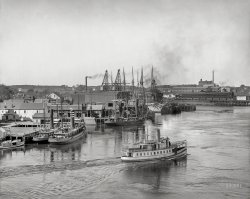
- Heavy Lifting: 1908
- ... not.
(The Gallery, Boats & Bridges, Buffalo NY, DPC, Railroads) ... Posted by Dave - 07/22/2012 - 10:40am -
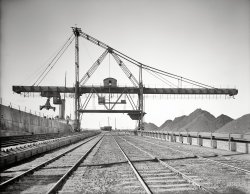
- Hoosac Tunnel: 1907
- ... come by at any time.
(The Gallery, DPC, Railroads) ... Posted by Dave - 08/11/2013 - 11:52am -
